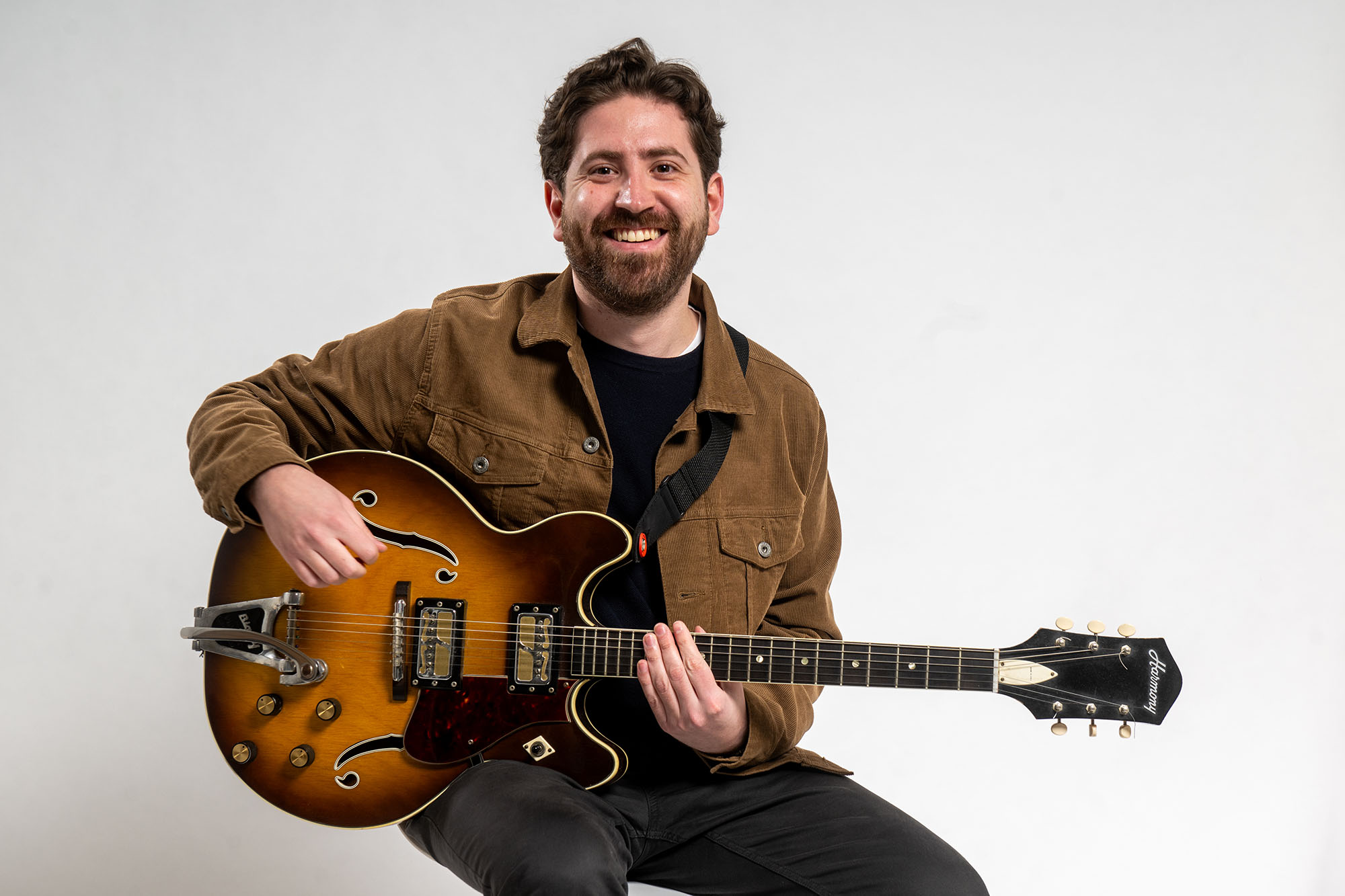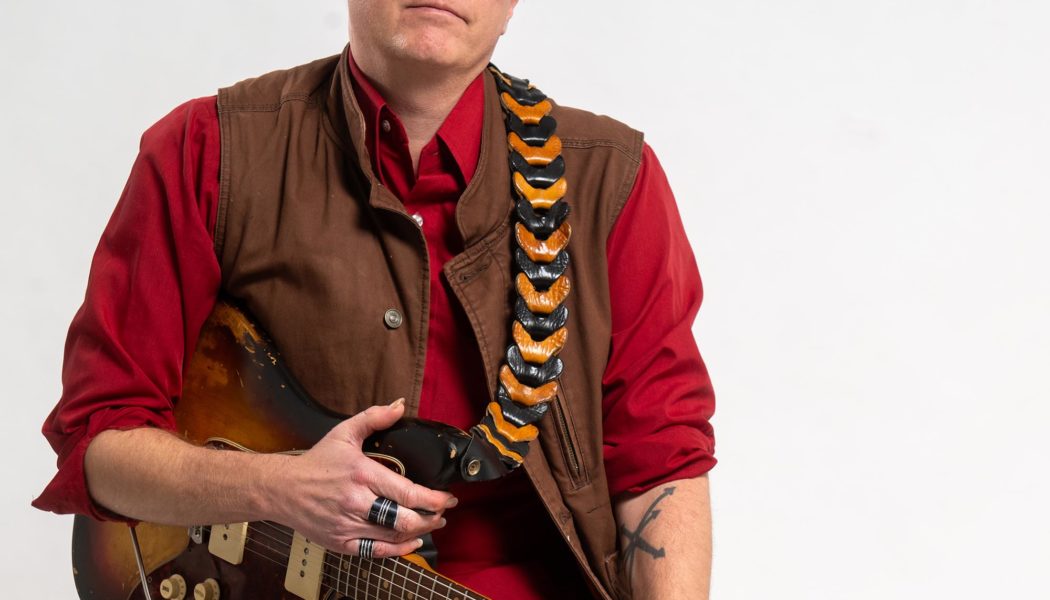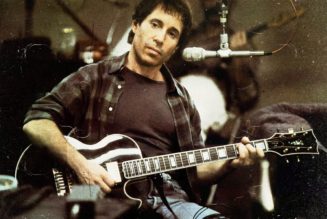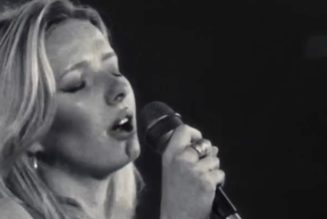Call it a six-string harmonic convergence.
The guitar has raised its profile at the College of Fine Arts School of Music lately, not via performance or theory classes, but thanks to five recent arrivals in the musicology and ethnomusicology department.
PhD students Nathaniel Braddock (CFA’25), Lance Morrison (CFA’25), Kumera Zekarias (CFA’26), and Brian Barone (CFA’24) arrived separately during the last few years. They all play guitar professionally, and the instrument is woven into their research. With the arrival in September of Erik Broess, a visiting assistant professor of musicology, they reached what feels like a quorum.
“They’re uniquely well-rounded. They don’t put up any barriers,” says Victor Coelho, a CFA professor of music, director of the Center for Early Music Studies, and chair of the department of historical performance. “That’s what I like about this whole group—how open they are about musical styles, about cultures. They’re always curious.
“The guitar doesn’t figure as a main line of development in music history books, which is unfortunate, because it has a very, very deep history,” adds Coelho, an expert lute player who also rocks out on his Fender Telecaster in the class he teaches on the Rolling Stones. “These young scholars are now studying the instrument as the main actor of a much larger global music history.”
The quintet’s research interests range from guitar in the African diaspora to the inner workings of the Fender Musical Instruments Corporation to the Boston hardcore punk scene in the 1980s.
“As a musicology and ethnomusicology department, we’re very much invested in tearing down the walls between the study of popular music, non-Western music, and Western classical music,” says Michael Birenbaum Quintero, a CFA associate professor of music and department chair. “The guitar is an instrument that sits at the intersection point of all of those things. Popular music obviously has a guitar, but so does classical music. And so does plenty of music outside the West.
“The ubiquitousness of the guitar, that chameleonic aspect of the guitar mirrors the possibilities available when you start, like in our department, breaking down some of those walls,” says Birenbaum Quintero, who also plays, although he is primarily a percussionist.
The ubiquitousness of the guitar, that chameleonic aspect of the guitar mirrors the possibilities available when you start, like in our department, breaking down some of those walls.
The five “are all brilliant, too,” he says. “You take a guy like Brian, who reads all the obscure guitar tablatures from the 17th century, but also is perfectly familiar with the inside of a recording studio in Lagos, Nigeria.”
“What’s interesting about the guitar is that it’s become such a globalized instrument, and that there are millions of different ways of playing it,” Barone says. “It’s involved now in so many different kinds of music around the world. And I think that’s actually what you see in our department, because we all work on really different kinds of music. What we have in common is the guitar. But that’s a commonality that embraces a lot of difference, a lot of diversity.”
“Anytime we see each other,” Broess says, “it’s nice to talk guitar, see what they’re up to, see what they’re playing, see what they’re listening to.”
“And of course,” Coelho says, “you can just sit there and talk about gear for five hours.”
We asked each of these scholar/musicians to tell us about their research and about a favorite guitar.

Nathaniel Braddock (CFA’25)
PhD student working on his dissertation on guitar music in Congo and the Congolese diaspora
His research: Braddock concentrates on African guitar music and the materiality of instruments. A materialist approach centers the physicality of instruments and infrastructure in understanding how music is made. He just completed a chapter for the forthcoming Cambridge Companion to the Electric Guitar, called “African Electrical Networks.” He has also written about the materiality of guitar in the music of James Blood Ulmer, Joni Mitchell, and St. Vincent.
His guitar and his music: A 1963 Fender Jazzmaster. Braddock plays African music, indie rock, and experimental music and is busy as a performer, leading several bands. He’s premiering music this month for two large-scale dance pieces in New York with a Ugandan-American choreographer in addition to several recording projects that are underway.

Erik Broess
CFA visiting assistant professor, musicology and ethnomusicology department, teaching a graduate seminar this semester on musical instruments, including the electric guitar
His research: Broess focuses on electric guitar gear and tone. He has an article coming in the Journal of the Society for American Music on Fender amplifiers made between 1948 and 1960. These amps were all hand-signed by the women who made them in the company’s Fullerton, Calif., factory. He got in touch with family members of the women to reconstruct their biographies for an employee-centered history of the early days of the electric guitar.
His research II: He is starting work on a book project about guitar tone, based on his dissertation. Broess follows various electronic components that guitarists believe are responsible for producing their instrument’s signature sound, and he tries to understand the different ideologies bound up in their discourse around sound. “I’m especially interested in the moments when guitarists resort to mythology and magic to discuss their instrument’s sound.”
His guitar and his music: “I’ve been playing guitar since first grade. I have played rock, metal, jazz, classical, and musical theater. This guitar is a 1969 Harmony Meteor. It is the kind of guitar that you could have bought out of a Sears catalog in the late ‘60s. [It has] some construction flaws that make it frustrating to play at times. But that is exactly why I love it. This old guitar makes me fight a bit for a good sound. It makes me try new things I would never do on a more comfortable guitar. On the back of the guitar are markings that look like teeth marks. If I were ever to give my guitars nicknames, this would be a good candidate. Maybe Jaws?”

Lance Morrison (CFA’25)
Sixth-year in the PhD program, now beginning his dissertation
His research: Analyzing Boston’s hardcore punk scene from 1981 to 1985 as the product of people, places, sounds, and ideas. “The scene has a long-lasting legacy in underground music and is assumed to be idiomatically Bostonian in both attitude and sound,” he says. Morrison is looking at the musical and cultural basis for these assumptions. Among the bands he focuses on are SS Decontrol, Negative F/X, Jerry’s Kids, and the F.U.s. He originally applied to BU intending to study Renaissance polyphony. What happened? “Life,” he says, without elaborating.
His guitar and his music: “I write punk and serial music. My 1997 Guild S-100 has been a good friend for several years. I first wanted it because Kim Thayil [lead guitarist of Soundgarden] uses one. It’s the most comfortable guitar I’ve played, and its tone is what I need—the phase switch is great.”

Kumera Zekarias (CFA’26)
PhD student in ethnomusicology and a teaching assistant in Professor Leland Clarke’s course The Music of Black Americans
His research: Zekarias’ interests are focused on música del Pacifíco, black music from the Pacific Coast of Colombia and Ecuador, and how Afro-Colombian music is passed through generations of community members. He’s currently researching the earliest recorded música del Pacifíco recordings from the 1960s, in which the electric guitar and bass were used to approximate the sonic characteristics and functions of percussion instruments in the traditional Pacific repertoire.
His guitar and his music: “I grew up in the Blues scene in Austin, Tex.. I’ve brought my oldest guitar, a 2001 Fender Stratocaster (MX). I’ve replaced the original pickups with ‘Jimi Hendrix pickups’ in the neck and middle position and a humbucker sized P-90 in the bridge. I’ve played and recorded blues, merengue, and guitar-based Oromo music from the Horn of Africa on this guitar.”

Brian Barone (CFA’24)
PhD candidate in musicology and ethnomusicology, completing his dissertation
His research: Barone focuses on the ways that the globalization of African and Afro-diasporic musics has led to an expansion in concepts of what music is and can be. While this research isn’t entirely guitar-focused, the guitar does pop up. “The guitar has been an important research tool for me, whether I’m using it to bring to life music of the past or playing music with people in the present.”
His music: He first learned to play pop, but in his teens became hooked on the technical challenges and subtlety of classical guitar, and he earned bachelor’s and master’s degrees in classical guitar performance. After that, he made his living as a guitarist in and around New York City—ironically, playing much less classical than popular and experimental music.
His guitar: “A Fender Stratocaster that my parents gave me as a gift when I was maybe 13 or 14 years old; over the years I’ve done a lot of work on this guitar to make it my most personal instrument, most recently swapping out the usual plastic pickguard with an anodized aluminum one like those used on some early Stratocasters in the 1950s. This instrument and I have grown toward each other over the years and now it’s the guitar through which I feel most myself as a player.”









